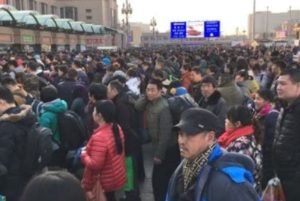China’s great migration under threat of extinction
It’s the world’s greatest migration event and there’s not a wildebeest or a waterbird in sight.
About three billion trips are expected to be made across China during the Lunar New Year celebrations, including more than 350 million rail journeys and 58 million flights.
Many of those crammed into trains and buses return home with a small bundle of cash and hopes of achieving the “Chinese Dream”, a vague, aspirational term, which was originally coined by Chinese President Xi Jinping.
 Hundreds of thousands of Chinese travellers are packing airports, train and bus stations as they head home representing the world’s largest seasonal migration of people as families reunite for China’s most important traditional holiday.
Hundreds of thousands of Chinese travellers are packing airports, train and bus stations as they head home representing the world’s largest seasonal migration of people as families reunite for China’s most important traditional holiday.
The Chinese will spend more than $US100 billion on eating and shopping and buying railway tickets online at a rate of more than a thousand second.
But this year – the Year of the Rooster – may be one of the last great migrations.
China’s economic boom was built on the back of migrants, who began arriving in the major cities a decade ago seeking a slice of the country’s new found wealth.
But flat-lining wages and the relocation of many factories overseas as raised uncertainty for many migrants, thousands of whom are returning to the villages and rural areas they came from.
China’s economic problems have particularly affected migrants to its cities.
About 280 million Chinese have migrated from the rural villages to work in China’s modern cities, leaving their children thousands of miles away in pursuit of tougher work, but higher wages.
Strict rules on housing registration has resulted in more than 60 million “left behind children” living with their grandparents or other relatives – a price that migrants are willing to pay in return for the prospect of a brighter future.
But that current status quo seems doubt as China’s economy grew by only 6.7 per cent in 2016, less than the 6.9 per cent of 2015, previously the weakest year in a quarter of a century.
The average salary for migrants is about 3,000 yuan, or $US436, a month, according to official statistics, but wage growth has slowed from 21 per cent in 2011 to just 7.2 per cent in 2015.
It is estimated to have fallen even further in 2016, according to a survey of experts by Bloomberg.
Meanwhile, many factories have shipped their production to countries with cheaper labour costs, such as Cambodia or Vietnam.
Around one per cent of migrants were owed back-pay in April 2016 – a 0.2 per cent increase on the previous year – and websites which monitor workplace protests have identified a huge increase in strikes in recent years.
The rising cost of living in China’s booming coastal cities is also forcing migrants to consider working locally, and recent figures suggest more than half find jobs in their home provinces.
The migration of migrant workers has grown as a phenomenon alongside China’s economic growth.
China’s trains have become more numerous and faster than even just a few years ago. More and more people are travelling by car or plane and China’s expanding high-speed rail network now covers about 20,000 kilometres of track.
Laurie Nowell
AMES Australia Senior Journalist












